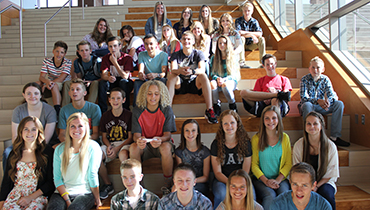Early college high schools are designed to provide a rigorous academic setting that allows students to earn their Associates degrees at the same time they earn their high school diplomas.
SUCCESS Academy has two campuses: one at Southern Utah University and one at Utah Tech University. SUCCESS Academy has a unique partnership with the Iron and Washington County School Districts which provides an early college experience without robbing students of a "normal" high school experience. Our partnerships allow students to attend SUCCESS Academy for half of their school day, where they enroll in both college prep and actual college courses. Students also attend their boundary school (the high school within the boundaries of the student's home address) for the other half of their school day, where they enroll in classes such as fine arts, applied technology, and physical education. This allows students to fully participate in sports, clubs, and extra-curricular opportunities with their boundary high school while challenging themselves academically by earning their Associates degree through SUCCESS Academy.
Once your student is admitted to the program, you may request to attend SUCCESS Academy either in the morning or afternoon. The SUCCESS Academy staff will do their best to accommodate your request, although it is not always possible. Students attending SUCCESS Academy in the morning begin their day with classes at SUCCESS Academy and then return to their boundary schools for lunch and afternoon classes. Students attending SUCCESS Academy in the afternoon begin their day with classes at their boundary school and eat lunch at their boundary school before coming to SUCCESS Academy for their afternoon classes. The schedule can be complicated at first, as the boundary schools are on A-day/B-day schedule and SUCCESS Academy follows a college schedule of MWF classes and TR classes, but students catch on quickly.
These students (SUU ONLY) take their core classes at SUCCESS to help them prepare for their college classes.
These students attend all classes with their cohort at SUCCESS Academy.
These students take Science, Math and English courses. Some of these can be college classes.
This year students take collegiate courses towards their Associates Degree and will start on their major courses.
All coursework is done on campus. Students attend regular college classes with the Southern Utah University or Utah Tech University student body. Students are encouraged to take courses that will apply to their desired major in addition to completing required courses to gain their Associate degree and their High School Diploma.

Concurrent enrollment provides high school students the opportunity to take college-credit bearing courses taught by college-approved high school teachers. It is a low-cost, scalable model for bringing accelerated courses to students in urban, suburban, and rural high schools. Students gain exposure to the academic challenges of college while in their supportive high school environment, earning transcripted college credit at the time they successfully pass the course. Concurrent enrollment also facilitates close collaboration between high school teachers and college faculty that fosters alignment of secondary and postsecondary curriculum. Sometimes called “dual credit,” “dual enrollment,” or “college in the high school,” concurrent enrollment partnerships differ from other models of dual enrollment because high school instructors teach the college courses. (source: nacep.org)
At the link below, there are links and summaries of major reports and studies on dual and concurrent enrollment. Included are a few of the growing number of rigorous, quantitative, large-scale studies on the academic outcomes achieved by students who took college courses while in high school. Most of these studies include concurrent enrollment as well as other forms of dual enrollment, including on courses taken on a college campus, via distance education, and/or taught by college faculty in the high school.
nacep.org/research-policy/research-studies